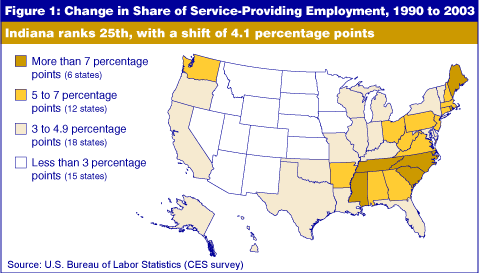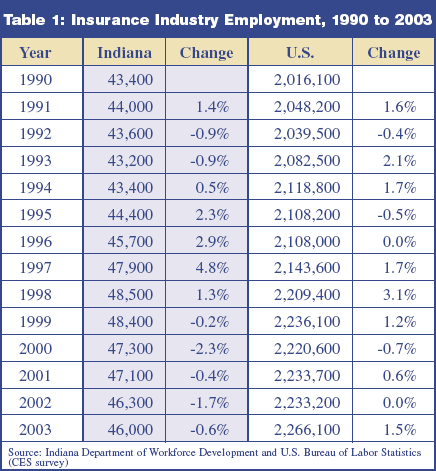Indiana's Insurance Industry
Indiana is home to 179 insurance companies, with another 1,660 licensed to do business in the state in 2004. Back in 2001 (the latest year available), the insurance industry contributed nearly $3.8 billion to Indiana’s gross state product.
Insurance premium tax receipts totaled more than $178 million in 2002, while Indiana insurance carriers paid Hoosiers an estimated $2.61 billion in direct income and $1.35 billion in indirect or induced income.
Employment and Wages
Looking at the 25 largest Indiana industry sectors (as defined by three-digit NAICS codes) reveals that Indiana’s insurance industry is the highest-paying nonmanufacturing sector and the third best-paying sector overall, according to Covered Employment and Wage (CEW) data.
In 2003, the average weekly wage for insurance workers in Indiana was $917, ranking it 15th among all reporting sectors and well above the Indiana average of $642.
The insurance sector is made up of a variety of subsectors that fall into two main categories: insurance carriers (such as life, health or casualty insurance) and insurance agencies, brokerages and related services. Here are a few facts gleaned from the Current Employment Statistics (CES) survey:
- In 2003, the Indiana insurance industry employed 46,000 people, ranking it 14th out of the 35 three-digit industry sectors surveyed.
- This employment size is slightly larger than the sectors for motor vehicle and parts dealers (42,300) and machinery manufacturing (43,800), while slightly smaller than the truck transportation (47,100) and primary metal manufacturing (52,300) sectors.
- Since 1990, Indiana insurance employment grew 6 percent, compared to 12 percent for the United States (see Figure 1).

- Growth in Indiana’s insurance industry employment lagged behind the country through 1994, but then strengthened through 1997 (see Table 1). Between 1998 and 2003, the United States grew 2.6 percent, while Indiana declined 5.2 percent.
- Monthly job data for 2004 show growth for both Indiana and the nation, with Indiana slightly leading.

Company Rankings (1)
Employment: Although exact rankings are not available, this information is based on InfoUSA company listings for employers with 2,000 or more workers in Indiana.
- Indiana’s largest insurance companies by employment are Anthem Health Systems, Conseco Services, Lincoln National Life Insurance and American United Life Insurance. Also included are Safeco Insurance Company of America, Golden Rule Insurance, Liberty Mutual Insurance, State Farm Mutual Auto Insurance and State Automobile Mutual.
- AON Service Corp., Key Benefit Administrators and the Forethought Group are the state’s largest insurance agencies and brokerage offices.
- Adminastar Federal is the largest third-party administrator of insurance funds.
Assets: Indiana has 25 insurance companies with over $200 million in assets, ranging from Lincoln National Life Insurance with assets of $67.8 billion to Mennonite Mutual Aid Association at $259 million.
- Indiana’s top nine life/health insurance companies with assets of $1 billion or greater are Lincoln National Life Insurance, American United Life Insurance, Anthem Health Systems, Conseco Annuity Assurance, Conseco Insurance, Safeco Insurance Company of America, Golden Rule Insurance, Liberty Mutual Insurance Company and State Farm Mutual Auto Insurance.
- Indiana’s top five property/casualty insurance companies with assets of $1 billion or greater are Safeco Insurance Company of America, Golden Rule Insurance, Liberty Mutual Insurance, State Farm Mutual Auto Insurance and State Automobile Mutual.
Revenue: While insurance companies are not among the leaders when considering the largest firms by employment size, they are among the state’s largest companies when compared by revenue size.
- The largest Indiana-based public companies by revenue include Anthem Health Systems (1), Conseco Services (5) and Baldwin and Lyons (46).
- Among the largest Indiana-based private companies by revenue are American United Life Insurance (1) and Farm Bureau Insurance (6).
Concentration, Taxes and Competition
The insurance industry is often mentioned as a possible industry to attract. Its employment levels show long-term growth, and although it is not immune to recessionary conditions, the effects are less severe. The problem is that the insurance industry, like many service sector industries, is closely linked to population and little influenced by geographic conditions. Of course, some exceptions exist. States showing industry concentration with respect to population include Connecticut, Nebraska, Iowa, New Hampshire, Minnesota and North Dakota.
One common trait for these states is their low tax rates for the insurance industry. In some cases, they show employment growth (Iowa and Nebraska). Connecticut, however, shows a sharp employment decline, especially from 1992 to 1996. Connecticut’s historic rates are not readily available, but it appears the state has lowered its tax rates and its employment has been relatively stable since 1997 and is slowly increasing.
Overall, tax rates appear to be continuing to decline. Indiana is lowering its premium rate and Iowa’s 1 percent rate is being phased-in between now and 2006. The competitive nature of lower premium taxes to attract new businesses and employees is most clearly seen in Colorado. Here, a new 1 percent rate is only for insurance companies with headquarters or regional home offices in the state.
While tax premiums are a fair indicator of employment growth trends, they vary over time. The insurance industry is also a service sector that is strongly influenced by changes in population. This is especially true for the agents and insurance brokers component of the industry.
Another fact for consideration is that many of the states with the fastest growth also have the lowest wages. This suggests that a large segment of insurance sector job growth is lower-paying, back-office functions and not high-wage headquarter operations. Even low annual average wages, however, still run $40,000 and up.
What is Indiana Doing to Be Competitive?
In 1998, the Insurance Industry Working Group was created to identify ways to improve the operating environment for Hoosier insurance companies.
As a result of work done by this panel and other industry supporters, several key pieces of legislation have been passed in recent years:
- An insurance premium tax rate reduction lowering rates incrementally from 2 percent to 1.3 percent by January 2006.
- A tax bill ensuring Indiana-chartered financial institutions are treated the same as nonresident institutions.
- The most modern demutualization legislation in the country, establishing the cleanest process for converting mutual companies into stock companies.
Also, several Indiana colleges and universities offer specialty programs in insurance industry skills:
- Indiana State University (ISU) students can earn an undergraduate degree in insurance and risk management. In 1999, the Gongaware Center at the School of Business was opened to support this degree program, to educate the insurance executives of tomorrow and to recruit top high school students. ISU also offers a distance education degree program in insurance.
- Ball State University offers degrees in actuarial science, as well as insurance. Both majors fall under the umbrella of the Center for Actuarial Science, Insurance and Risk Management, which encourages its faculty to conduct applied research to benefit the insurance industry and the people and businesses dependent upon it.
- Ivy Tech State College has 23 campuses across the state and offers an insurance specialty associate degree that prepares students to perform customer service functions. Graduates of the program are eligible for employment in customer support positions, rating positions, claims handling positions and others.
Notes
- The information used in this section comes from both public (employment) and private sources (assets and revenues). This gives a broader perspective in understanding relative strengths of insurance sector companies, but there are some inconsistencies and gaps in the information. Employment information is for all companies, but confidentiality restrictions prevent exact rankings. Information in both the asset and revenue sections comes from the Indianapolis Business Journal 2004 Book of Lists. Asset information is for insurance companies only. Revenue data is for all Indiana-based companies. Data for Golden Rule is not listed for assets or revenue.
Ted Jockel
Senior Economist, Indiana Department of Commerce
